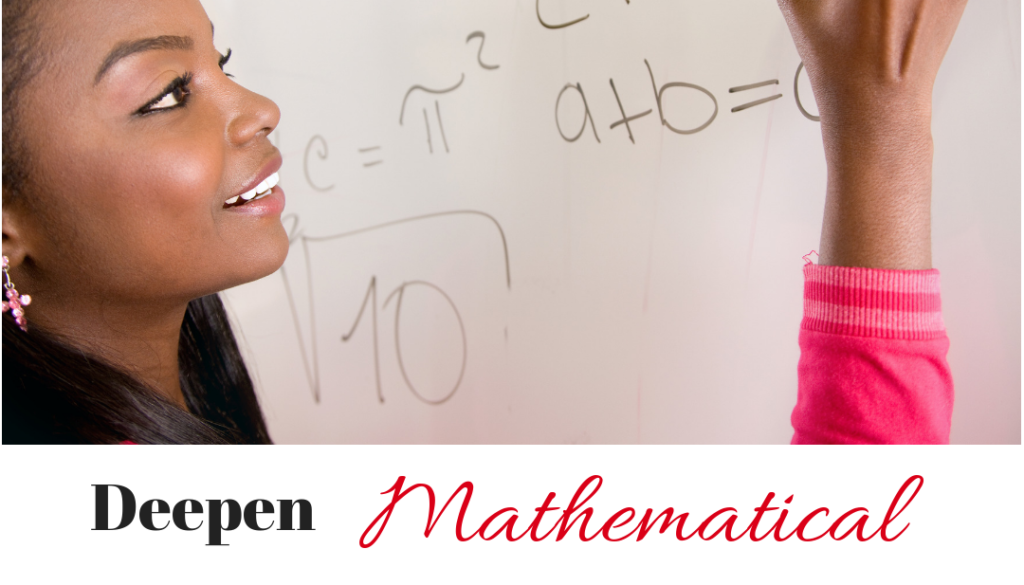Deepen Mathematical Understanding Through Writing
Deepen Mathematical Understanding Through Writing
Guest Post Written By: Gretchen of Always A Lesson
The assumption many students have about learning math is that there is minimal writing required in order to understand the concepts. When in actuality, writing is very much a part of the learning process. In fact, when done successfully, writing can deepen a student’s understanding of mathematical concepts.
Writing does not have to be a separate subject only taught in isolation. It can be taught at the same time as math because writing is a means by which to learn something rather than just a subject taught in school. It provides the brain additional think time to process concepts as the hand writes on paper. As a result, teaching these two subjects together only enhances the learning experience for students because they can strengthen their writing skills while computing and strengthen their math skills while writing.

Students tend to struggle in math due to a lack of time and effort to process the newly taught concepts, both of which can be eradicated by teachers implementing more writing activities into their lessons. Currently, in most math classes, students do not write for extensive periods of time or even often enough. Of course, students write numbers to solve math problems, but rarely do they write using words to express their thinking. This lack of writing in the learning process is a missed opportunity to help students gain proficiency in mathematical concepts.
Knowing that writing can enhance student skillsets in math, teachers need to build time for it into their math instruction. They can start by giving writing assignments in small increments, slowly adding in more writing time over subsequent weeks until students are writing and solving math problems in unison. It might feel awkward at first for students, but so do most new skills while you are acquiring them. Over time, writing and solving math problems in unison will become habit and feel quite natural for everyone.
There are a variety of ways in which teachers can weave writing in throughout their math block- before, during, and after learning experiences.
Gearing Up for Learning
A pre-learning activity helps students’ brains get into ‘learning mode’ before jumping into the heavy content of the lesson. Teachers should take advantage of this method by incorporating a small writing activity for students to complete at the start of the math lesson. Warming up through writing about math can be completed in just a matter of minutes.
Students can…
- Review the lesson objective or topic and write their predictions for what they think they will learn, how they will learn it, why it is important, and so on
- Goal set by reviewing past learning goals, track current ones, set new goals, etc.
(This writing activity is low risk since it is opinion writing, meaning there is no right or wrong answer and the focus is not on the perfection of students’ writing skills, but on the substance in the writing.)
Taking in Learning
Now that students have warmed up their brains and are ready to dive into the heavier content of the lesson, teachers can incorporate more substantial writing activities into the math instruction to aid in student learning.
Students can…
- Take notes on math problem solving strategies, vocabulary, or algorithm procedures
- Make simple observations in writing about math problems completed in a model demonstration by the teacher prior to a class discussion
- Complete a ‘Stop and Jot’ on a sticky note to record a thought, question, comment, or response to a mathematical prompt before moving on in the lesson
These activities are more extensive than a pre-writing activity but are still brief enough to keep the lesson moving. This short writing opportunity creates a mental math break and enables students to comprehend content in smaller chunks so that the concepts can sink in before tackling more information. As a result, students are armed with a stronger knowledge base that increases their confidence to correctly complete math assignments now and in the future.

Demonstrating Learning
It is of utmost importance that students demonstrate their learning as soon as possible in order to solidify the newly learned knowledge. It is especially true in math, where much of the concepts are achieved through repetitive practice.
Instead of having students complete math problem after math problem, teachers can mix up the learning experience with writing activities.
Students can…
- Write the rationale for how they solved a math problem with a specific strategy
- Review a peer’s work for potential errors they made and reply with written clues to help them fix it
- Complete a ‘Graffiti Walk,’ where students rotate from table to table filled with work samples and write graffiti-style on the paper with their comments
- Use a writing prompt to reteach a mathematical procedure or concept to a peer pen-pal
(This could be completed in a journal format throughout the year for different concepts taught.)
- Prepare for an active class discussion by writing a reflection to gather their thoughts
Continuing Learning
Just because the math lesson stops when the bell rings, doesn’t mean the learning has to stop for students. Additional math-based writing opportunities can be included in the learning experience after class is over.
Students can…
- Complete daily reflections on what they learned that day, what they struggled with, strategies they are comfortable using to solve complex problems, etc.
- Write in their journals to a peer pen pal to reteach concepts in a variety of ways (similar to how a teacher will differentiate to teach the same concept multiple ways to meet student needs)
- Take a peer’s math work paper home and write a letter back to them including praise for the strengths in their work and suggestions for correcting errors
Students can hone their math skills through a variety of writing activities before, during and after their learning experiences. It is important that the writing activities are low stakes to encourage participation rather than perfection. When teachers avoid correcting writing abilities and focus on writing as a mode by which to process math concepts, students will begin to rely on using writing as a comprehension method. This increases student comfortability and confidence. Writing is simply an additional strategy they learn to use in efforts to gain a deeper understanding of mathematical concepts.




